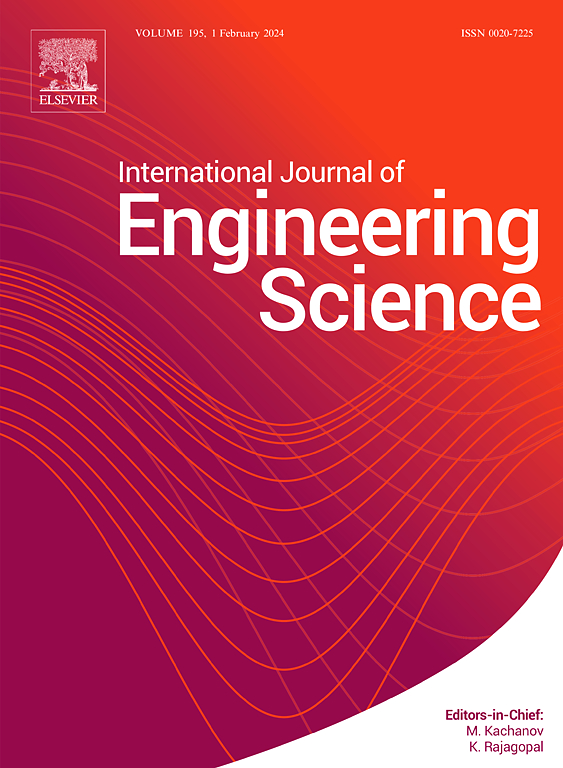Further developments in the constitutive theory of the family of models with higher order rational approximant response functions for application to isotropic compressible soft solids
IF 5.7
1区 工程技术
Q1 ENGINEERING, MULTIDISCIPLINARY
International Journal of Engineering Science
Pub Date : 2025-07-14
DOI:10.1016/j.ijengsci.2025.104336
引用次数: 0
Abstract
In a series of prior papers, various members of a new family of incompressible constitutive models whose response function(s), namely and , are of higher order rational approximants in invariants and were devised for application to the finite deformation of isotropic rubber-like materials. The extension of the models at the bottom of the hierarchy of this family; i.e., with and of orders [1/1] and [0/1], respectively, to the compressible case has been presented previously (Anssari-Benam & Horgan, 2022a). The current work is concerned with developing the compressible forms of the recently developed incompressible models at the top of the hierarchy of this family, where and are of further generalised orders; e.g., [/1] and [1/1], respectively. The improvement in the accuracy of the modelling results will be demonstrated, on using extant multiaxial and uniaxial experimental datasets of a wide variety of compressible soft solids, ranging from polyethylene foams to (hydro)gels and biological materials. The presented developments here complete hitherto the extension of the incompressible forms of this family of models to the compressible case, and provide more accurate constitutive models for application to the large deformation of compressible soft materials.
各向同性可压缩软固体高阶有理近似响应函数模型族本构理论的进一步发展
在之前的一系列论文中,设计了一组新的不可压缩本构模型族的各个成员,其响应函数W1和W2在不变量I1和I2中具有高阶有理近似,用于各向同性橡胶类材料的有限变形。在这个家族的层次结构底部的模型的扩展;即,W1和W2的阶数分别为[1/1]和[0/1],可压缩情况之前已经提出过(Anssari-Benam &;Horgan, 2022)。目前的工作是发展最近发展的不可压缩模型的可压缩形式,其中W1和W2是进一步的广义阶;例如,[β/1]和[1/1]。建模结果准确性的提高将通过使用现有的多轴和单轴实验数据集来证明,这些数据集包括各种可压缩软固体,从聚乙烯泡沫到(氢)凝胶和生物材料。本文的发展完成了迄今为止这类模型的不可压缩形式向可压缩情况的扩展,并为应用于可压缩软材料的大变形提供了更准确的本构模型。
本文章由计算机程序翻译,如有差异,请以英文原文为准。
求助全文
约1分钟内获得全文
求助全文
来源期刊

International Journal of Engineering Science
工程技术-工程:综合
CiteScore
11.80
自引率
16.70%
发文量
86
审稿时长
45 days
期刊介绍:
The International Journal of Engineering Science is not limited to a specific aspect of science and engineering but is instead devoted to a wide range of subfields in the engineering sciences. While it encourages a broad spectrum of contribution in the engineering sciences, its core interest lies in issues concerning material modeling and response. Articles of interdisciplinary nature are particularly welcome.
The primary goal of the new editors is to maintain high quality of publications. There will be a commitment to expediting the time taken for the publication of the papers. The articles that are sent for reviews will have names of the authors deleted with a view towards enhancing the objectivity and fairness of the review process.
Articles that are devoted to the purely mathematical aspects without a discussion of the physical implications of the results or the consideration of specific examples are discouraged. Articles concerning material science should not be limited merely to a description and recording of observations but should contain theoretical or quantitative discussion of the results.
 求助内容:
求助内容: 应助结果提醒方式:
应助结果提醒方式:


